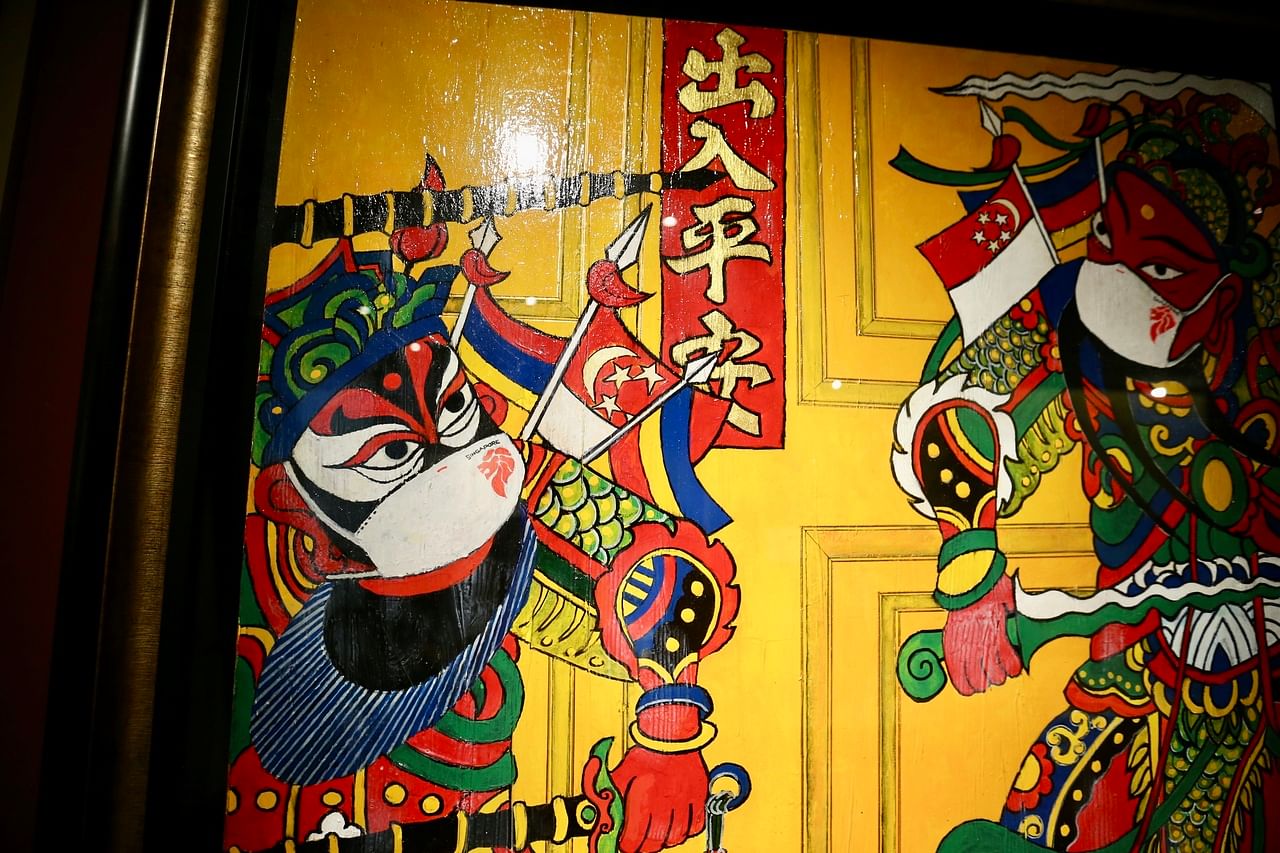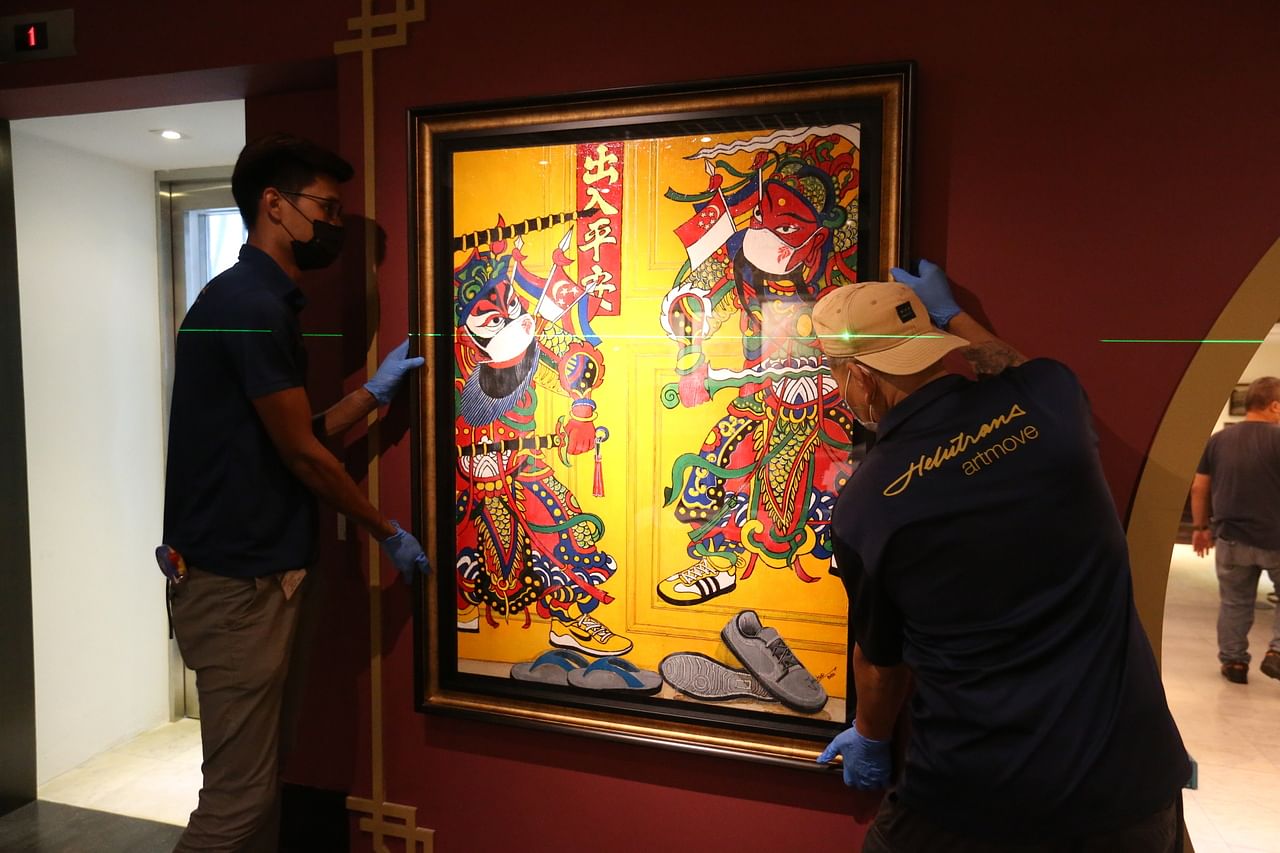Chinese door deities with Malay dagger stand guard at Chinese New Year exhibition
Sign up now: Get ST's newsletters delivered to your inbox

The two deities are not only donning masks, but also guarding a door painted orange to depict Singapore's disease outbreak response system condition level.
ST PHOTO: SAMUEL ANG
Follow topic:
SINGAPORE - Wood prints of door deities once adorned homes in villages during Chinese New Year, in hopes of driving away bad omens and evil spirits.
But the deities that local artist John Soo depicted for the Nian Hua (Chinese New Year prints) exhibition at the revamped Sun Yat Sen Nanyang Memorial Hall in Balestier have a local touch.
"For example, the Chinese door spirits hold a keris - a powerful weapon (dagger synonymous with Malay culture) that casts away spirits.
"A red dot can also be seen on their foreheads, symbolising the Indian belief that if someone were to do good to you, you have to do good to them.
"So by doing good to each other, say, putting on masks for other people's sake, we can stop the spread of disease," said Mr Soo.
The two deities are not only donning masks, but also guarding a door painted orange to depict Singapore's disease outbreak response system condition (Dorscon) level, which the country moved to in February 2020 amid the Covid-19 pandemic.
This year's exhibition, titled Nian Hua: Of Deities, Guardians And Auspicious Art, was organised in collaboration with the Three Gorges Museum in Chongqing, China.
It features close to 70 artefacts originating from different Chinese provinces.
Nian Hua, which translates to "new year prints", are auspicious symbols dating back to the Qing dynasty. The prints are usually carved on woodblock, with the more intricate details painted by hand.
Speaking to The Straits Times on Jan 21, the museum's curator, Ms Jermaine Chua, said new year prints remain an important art form in Chinese culture.
She added that the characters, motifs and stories depicted reflect the "values, beliefs and traditions practised by generations of families, and their hopes and wishes for the future".
"By taking a closer look at Nian Hua, we also gain a better understanding and appreciation of our intangible cultural heritage," said Ms Chua.

ST20220111_202288670032 / cfsunyatsen12-ol / Samuel Ang / Art handlers from Helutrans set up a large two panel traditional nian hua, at the Sun Yat Sen Nanyang Memorial Hall, for the exhibition, "Nian Hua: Of Deities, Guardians and Auspicious Art". Jan 11, 2022.
PHOTO: ST
The hall is split into four sections: Door Deities and Guardians; Kitchen God, Earth God and other Deities; Blessings for the Bedchambers; and Happiness, Prosperity and Longevity.
Woodblock moulds sourced from a private lender in Singapore will also be showcased for the first time.
Mr Loo Say Chong, a private collector and researcher who loaned two woodblock moulds, said: "Woodblock printing has an important place in Chinese history and culture. It is a craft that requires precision, both during carving and during alignment for printing."
The exhibition also includes curated prints from the National Museum of Singapore, Asian Civilisations Museum and Singapore Art Museum, and modern-day interpretations of Nian Hua by local artists.
Apart from artwork, visitors can also take part in a lantern-making workshop.
It will be conducted by Mr Jimm Wong, one of the last traditional lantern makers in Singapore making Fuzhou- and Cantonese-style lanterns.
"I hope that by conducting this workshop, I can spark some interest in the younger generation of our roots and the arts, and pass on my knowledge and skills," said Mr Wong.
The exhibition will run from Jan 21 to Sept 25 at the museum's gallery five.

